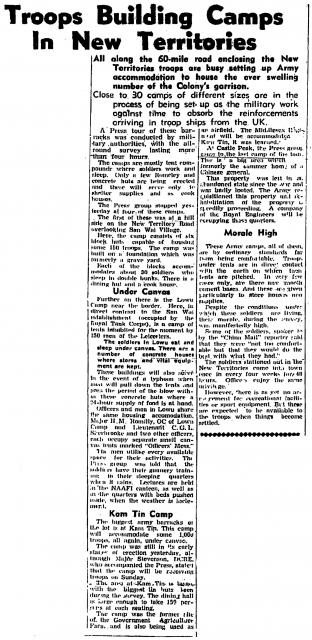Might help those interested in the origins of the NT's military sites and when they were constructed.
Zoom in to read the text

Might help those interested in the origins of the NT's military sites and when they were constructed.
Zoom in to read the text
Comments
Text of article
Troops Building Camps In New Territories
All along the 60-mile road enclosing the New Territories troops are busy setting up Army accommodation to house the ever swelling number of the Colony's garrison.
Close to 30 camps of different sizes are in the process of being set up as the military work against time to absorb the reinforcements arriving in troop ships from the UK.
A Press tour of these barracks was conducted by military authorities, with the all-round survey lasting more than four hours.
The camps are mostly tent compounds where soldiers work and sleep. Only a few Romeley [sic. - probably meant Romney Huts] and concrete huts are being erected and these will serve only to shelter supplies and as cook houses.
The Press group stopped yesterday at four of these camps.
The first of these was at a hill side on the New Territory Road overlooking San Wai Village.
Here, the camp consists of six block huts capable of housing some 150 troops. The camp was built on a foundation which was formerly a grave yard.
Each of the blocks accommodates about 30 soldiers who sleep In double bunks. There is a dining hut and a cook house.
Under Canvas
Further on there is the Lowu Camp near the border. Here, in direct contrast to the San Wai establishment (occupied by the Royal Tank Corps), is a camp of tents inhabited for the moment by 130 men of the Leicesters.
The soldiers in Lowu eat and sleep under canvas. There are a number of concrete houses where stores and vital equipment are kept.
These buildings will also serve in the event of a typhoon when men will pull down the tents and pass the period of the blow within these concrete huts where a 24-hour supply of food is at hand.
Officers and men in Lowu share the same housing accomodation. Major H.M. Romilly, OC of Lowu Camp and Lieutenant C. G. I. Sherbrooke and two other officers, each occupy separate small canvas tents marked "Officers' Mess."
The men utilise every available space for their activities. The Press group was told that the soldiers have their gunnery training in their sleeping quarters when it rains. Lectures are held in the NAAFI canteen, as well as in the quarters with beds pushed aside, when the weather is inclement.
Kam Tin Camp
The biggest army barracks of the lot is at Kam Tin. This camp will accommodate some 1,000 troops, all again, under canvas.
The camp was still in its early state of erection yesterday, although Major Stevenson, DCRE, who accompanied the Press, stated that the camp will be receiving troops on Sunday.
The area at Kam Tin is large, with the biggest tin huts seen during the survey. The dining hall is large enough to take 150 persons at each seating.
The camp was the former site of the Government Agriculture Farm, and is also being used as an airfield. The Middlesex Regiment will be accommodated at Kam Tin, it was learned.
At Castle Peak, the Press group came to the last camp of the tour. This is a big area which was formerly the summer home of a Chinese general.
This property was left in an abandoned state since the war and was badly looted. The Army requisitioned this property and rehabilitation of the property is speedily proceeding. A company of the Royal Engineers will be occupying these quarters.
Morale High
These Army camps, all of them, are by ordinary standards far from being comfortable. Troops under tents are in direct contact with the earth on which the tents are pitched. In very few cases only, are there any smooth cement bases. And these are given particularly to store houses and supplies.
Despitec the conditions under which these soldiers are living, their morale, during the survey was manifestedly high.
Some of the soldiers, spoken to by the "China Mail" reporter said that they were "not too comfortable but that they would do the best with what they had."
The soldiers stationed out in the New Territories come into town once in every four weeks for 48 hours. Officers enjoy the same privilege.
However, there is as yet no arrangement for recreational facilities or sport equipment. But these are expected to be available to the troops when things become settled.